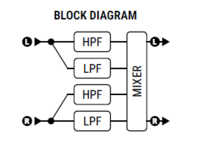This is the wiki for products made by Fractal Audio Systems, maintained by members of the community.
November 2025: the entire wiki has been updated with information about the new AM4 amp modeler.
Difference between revisions of "Crossover block"
Jump to navigation
Jump to search
| Line 48: | Line 48: | ||
=Tips and tricks= | =Tips and tricks= | ||
| + | |||
| + | ==Bi-amping== | ||
Some bass/guitar players split their signal in highs and lows, and send them through different amplifiers. This can be accomplished with the Crossover block. The factory preset "Plexi Bi-Amp" demonstrates this. | Some bass/guitar players split their signal in highs and lows, and send them through different amplifiers. This can be accomplished with the Crossover block. The factory preset "Plexi Bi-Amp" demonstrates this. | ||
Revision as of 10:38, 15 May 2019
Contents
Available on which products
- Axe-Fx III: 2 blocks
- FM3: probably not
- Axe-Fx II: 2 blocks
- FX8: no
- AX8: no
Channels or X/Y switching
- Axe-Fx III: 2 channels
- Axe-Fx II: no
What is a crossover
The Crossover block is a simulation of an electronic crossover. A crossover splits the audio signal into multiple frequency ranges, which then can be processed or amplified separately.
More explanation:
Parameters table
| Parameter | Axe-Fx III | Axe-Fx II |
|---|---|---|
| Lo/Hi Level Left/Right | yes | yes |
| Lo/Hi Pan Left/Right | yes | yes |
| Frequency | yes | yes |
| Frequency Multiplier | yes | yes |
Tips and tricks
Bi-amping
Some bass/guitar players split their signal in highs and lows, and send them through different amplifiers. This can be accomplished with the Crossover block. The factory preset "Plexi Bi-Amp" demonstrates this.
